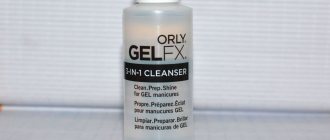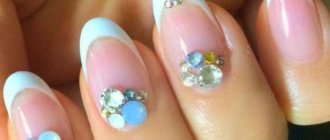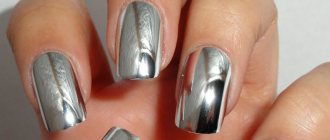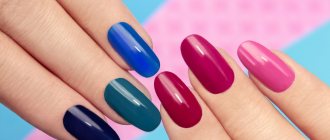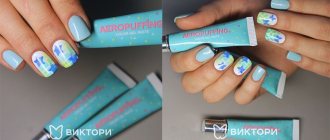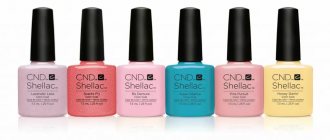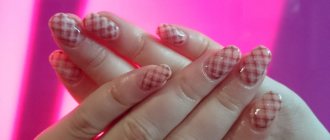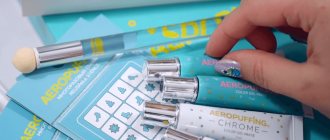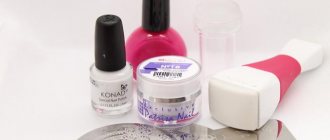How to replace a clinser
It happens that the clinser runs out at the most inopportune moment and in such situations the question of replacement arises. Let's start with what should not be replaced with a clinser:
- nail polish remover with acetone .
The strongest solvent in the composition is designed to destroy the bonds of coatings, so even in minimal quantities it can affect the durability of the manicure. In addition, after using a solvent, the surface may lose its shine and become cloudy; Coating remover - how to choose and use - degreaser. A degreaser, if it is not a universal 2 in 1 product, is used to remove sebum, while the cleanser destroys the breakdown products of the material. You can use a degreaser to remove stickiness, but only as a last resort. After using a degreaser for purposes other than its intended purpose, cracks in the coating may appear faster;
If you don’t have a clinser at hand, you can remove the stickiness:
- alcohol wipes. Alcohol-impregnated wipes are purchased for medical purposes - local injections or wound treatment. Alcohol wipes remove stickiness well, practically without harming the color and quality of the coating;
- medical alcohol or alcohol tincture . Before using such a “cleaner”, it is recommended to dilute the alcohol with water in a ratio of 1:3 – 1 tablespoon of alcohol to 3 tablespoons of water to reduce the concentration. Concentrated alcohol dries out the skin and causes the coating to become cloudy.
Of course, to work with the inhibited layer, it is better to use specialized products that do not harm the manicure and the skin around the nails, or purchase a non-sticky top, for example, from Kodi with the “No sticky” mark.
Types of topcoats: how to choose a topcoat, review of the 10 best brands
Definition of sticky layer
The sticky or dispersion layer is a special protective layer that helps the varnish adhere to the surface and dry faster. However, despite its benefits, this substance has many disadvantages that are harmful to human health:
- when it is present on the hands, people may experience a severe allergic reaction that causes coughing or difficulty breathing;
- when a person inhales dust with tiny particles of the sticky layer, this can provoke the development of respiratory tract diseases;
- sometimes the sticky layer has a not entirely pleasant smell.
Many people are interested in the question of how to remove the sticky layer. Professionals in their field always prefer to use a special liquid, which can be very expensive. Sometimes such purchases hit the pocket hard, and then people begin to look for other answers to the question of how to remove the dispersion layer. There is a way out - there are many other means that can be used to remove the dispersion layer of gel polish. What should you still give preference to?
How to choose a cleaner
- compound . Make sure that the composition contains oils - lavender, rosemary. And extracts, for example, chamomile. Additional components take care of the nail and allow the cleanser not to dry out the skin;
- clinsers with pump dispenser . They are much more convenient to use and allow you not to be distracted by wetting the napkin;
- smell. A pungent odor, both chemical and fragrance, can cause headaches if inhaled for a long time. Try to purchase cleansers with an unobtrusive smell.
What is a primer and when is it needed?
Mysterious nail cleaner: what is it? We understand its purpose and look for analogues
Gel manicure has become such a part of the basic care of fashionistas that many of them already prefer to do their own gel nail polish at home. Armed with knowledge gleaned from the Internet and “observing” the actions of professional masters during trips to salons, newly minted craftswomen sometimes create nail design masterpieces on their nails and the nails of their friends that are in no way inferior to the results of professionals.
Photo from the site: makeup-spb.ru
Naturally, on the way to improving their skills, many people have questions regarding manicure techniques and materials for it. One of these strange materials is nail clinser. What is it, why is it needed and its possible analogues - undoubtedly, these and other questions will be of interest to novice craftsmen. So, first things first.
What is a nail clinser? Understanding the concept and content
You will be surprised, but what experienced masters call the mysterious word “cleanser” and claim that without it a high-quality manicure is not possible, you may also use it, but you just don’t know it. A nail cleaner is nothing more than a degreaser. Yes, yes, the same one that you use to prepare the nail plate for applying the base gel polish, and it is also used to remove the dispersion layer at the finishing stage of the gel manicure.
Surprised? Now look at your bottle of degreaser; it probably says “Cleanser” on its label. And this is not the name of the company, this is precisely the name of the product group of manicure products.
Photo from the site: specialvip.ru
Klinser is a water-alcohol solution with fragrances and special oils. This substance is simply necessary for a quality manicure and is a fairly universal product. Let's look at a wide range of its uses:
- You can treat your hands with a cleanser before a manicure. In other words, it acts as an antiseptic, preventing the penetration of bacteria and fungi into the nail plate.
- Cleanser can also be used to disinfect manicure equipment. The alcohol content in the solution is optimal for this procedure.
- Some expensive brands of clinser can also be used to process lamellas for baking nails.
- Klinser removes the water-fat layer from the nail plate and thus ensures the best adhesion of natural keratin to gel polish.
- Klinser is what is simply necessary at the final stage of any gel coating. It removes the sticky layer and thereby provides a beautiful glossy shine to the artificial coating and gives additional strength to the manicure.
Analogue version of the clinser – dehydrator
Having dealt with the question of what a clinser is, let's take a closer look at its most common analogue - a nail dehydrator. Undoubtedly, many have heard about it, and perhaps this is what you use to degrease the nail plate and remove the dispersion layer. Perhaps someone will even decide that these are again different names for the same product. And someone, reading the previous section, will decide that they are missing an important point in manicure by using a dehydrator and forgetting about the cleanser.
Photo from the site: nogti.viberi.net
Both are wrong. Yes, a dehydrator and a cleanser have similar functions, properties and purposes, but they are completely different means. Thus, the cleanser acts more gently and removes only the natural fat layer from the nail plate. A dehydrator, in addition to removing the fat layer, removes excess water from the nail plate, penetrating deep into the nail. Thus, the dehydrator provides more reliable adhesion to the nail plate.
Interesting
Despite the fact that the dehydrator dries out the nail plate, it is the most gentle product among the group of degreasers. Its main active ingredient, butyl acetate, evaporates very quickly. After using the dehydrator, the pH balance is restored in the shortest possible time. In addition, once it gets on the skin, it does not cause irritation or allergic reactions.
Naturally, everyone must decide for themselves which product they will use to prepare their nails for applying gel polish. You just need to indicate in what cases it would be more appropriate to use one or another degreasing solution.
- If you have “wet” nails, then a dehydrator is your option. How to determine the “wetness” of nails? Only by experience. You may have noticed that you or your friends' manicures, done according to all the rules, begin to come off after just a couple of days, while for others it lasts for weeks. And so time after time. All this means that your nails are too wet. It is in your case that a dehydrator is the best option.
- If, on the contrary, you have excessively dry nails, then a dehydrator is contraindicated for you, because it will dry them out even more. You can also “identify” a dry nail plate experimentally. As a rule, after applying a dehydrator, the free edge of “dry” nail plates curls into a kind of cone. It is in this case that only a clinser should be used.
What to use at the final stage is no longer so important, and the cleanser and dehydrator do an excellent job of removing the sticky layer and providing a glossy shine to the manicure.
Rules for using the clinser
Klinser is quite easy to use and does not require any special skills. It is enough just to blot a napkin with the solution and treat your nails. However, there are a number of rules that, if followed, will ensure a long “life” for your manicure.
Photo from the site: megaalaki.ru
- Try to use clinsers of the same brands as gel polishes. Gel manicure products from the same company perfectly complement each other and “do not conflict” with each other. Thus, the gel coating under the influence of a “foreign” cleaner may fade or change color.
- If it is not possible to purchase manicure products from one company, then at least take care of a high-quality cleaner. You shouldn't skimp on it. So, an expensive cleaner will never ruin your manicure, while cheap brands can affect its final effect. This is especially true for inexpensive brands of gel polish.
- Always use lint-free wipes in pair with the cleanser. Never use regular cotton pads. This is especially true when preparing the nail plate for applying the base layer. There is a risk that the lint from the cotton wool will remain on your nails and your manicure will be ruined.
- Apply the clinser to the nail plate immediately before you start applying gel polish. You should not treat all your nails at once, because after 30 minutes the effect of the cleaner wears off.
- Under no circumstances should you do a manicure without degreasers. Neglecting this rule will result in the gel coating coming off at the first contact with water.
- Be sure to remove the sticky layer at the finishing stage. If it is not removed, the gel coating will lose its attractive shine, and this is in the best case. At worst, you risk developing an allergy, because the dispersion contained in gel polishes can cause an allergic reaction.
Important
Degreasers for gel manicure are used only at the initial stage, before applying the base, and after applying the topcoat. Do not degrease the gel coating between other stages of manicure. This way you will remove the dispersion formed after drying in the lamp, which precisely ensures reliable adhesion between all layers of gel polish. In addition, a number of cleansers contain oils, which will be an additional obstacle to the adhesion of the gel layers.
How can I replace a nail clinser?
It is possible that many, while reading the material, had a question - is a cleanser or dehydrator really necessary for manicure? After all, in fact, both products contain alcohol.
Photo from the site: caringmother.ru
Indeed it is. But before we begin to consider what can replace a clinser, it is worth mentioning that analogues can only be used in the most extreme cases, for example, when a special nail degreasing agent suddenly runs out. So, alternative means:
- Aqueous-alcohol solution in a ratio of 70:30 (water/alcohol).
- Non-acetone nail polish remover. A liquid containing acetone will deprive the manicure of its glossy shine and even change the color, making it dull and cloudy. In addition, strong undiluted acetone can even partially remove the gel coating.
- Boric or formic alcohol.
- Vodka. Definitely high quality. It’s even better to use homemade vodka, commonly referred to as moonshine, rather than a cheap surrogate, which can lead to cloudy color. But high-quality vodka is perhaps the only analogue that, in terms of its characteristics, can even compete with clinser.
Thus, an incomprehensible and mysterious nail clinser is nothing more than a preparatory base and fixer for a gel manicure. It is not the most obvious element in creating a manicure, which sometimes beginners forget about or don’t even think about when purchasing materials, but as practice shows, the appearance and durability of a manicure made with gel polish depends on it.
data-block2= data-block3= data-block4=>
idealnyi-manikur.ru
The best cleansers for removing stickiness
Sophin
The liquid has an unobtrusive odor and effectively removes the sticky layer. The active ingredient is isopropyl alcohol.
Grattol, Liquid 3 in 1
A multifunctional product suitable for making it easier to work with polygel, degreasing the nail plate and removing stickiness after polymerization. Prevents chipping and also gives the top coat extra shine.
Kinetics, Di-Tac
The peach scented cleanser is suitable for treating nails after polymerization, as well as for cleaning brushes after gel, polygel and acrylic. To remove stickiness, a cotton pad is moistened with liquid and used for its intended purpose. To clean your brushes, wrap the fleecy part in a soaked cotton pad or sponge for a couple of minutes.
Kodi Cleanser
The liquid allows you to remove the result of the decomposition of the material after polymerization without compromising the gloss of the coating. To prevent the color from becoming cloudy, the manufacturer recommends using a clean part of the napkin for each nail and covering the nails with Kodi top coat.
Severina, Adhesive Remover
Liquid for removing the sticky layer while maintaining the shine of the coating. The composition includes panthenol, which moisturizes and softens the skin around the nails. Can be used as a nail polish remover for natural and artificial nails.
Best nail dehydrators
Products in this category are suitable for both professional and home use. Dehydrators remove moisture from the surface of the nail, but do not destroy its layers. Primers are most popular among craftsmen who do shellac and gel modeling.
MILV Nail Prep
A Russian-made degreaser for gel polish is designed for short-term dehydration and deep cleaning of the surface. The covering can be worn for up to 7-8 weeks. The primer is used before applying any type of artificial material. The cost of a 16 ml bottle is 170 rubles.
Advantages:
- transparent bottle - you can determine in advance that the drug will soon run out;
- with antibacterial effect.
Flaws:
- the brush is uncomfortable and moves away when applied;
- According to reviews, it does not always fulfill its functions.
Kodi Professional Nail fresher
A degreaser for cleansing and dehydrating the nail acts superficially, without penetrating into the deep layers of the nail plate, and therefore does not destroy its structure. The dehydrator is applied before any artificial turf, significantly extending the wear period. Price – 450 rub. (15 ml) and 1 thousand rubles. (160 ml).
Advantages:
- does not cause allergies;
- dries quickly and well;
- Convenient brush in a small bottle.
Flaws:
- expensive;
- When used professionally, it is quickly consumed.
Patrisa Nail Nail Prep
Powerful dehydrator contains ethyl acetate, isobutyl acetate, isopropyl, no dyes or fragrances. The product removes moisture from the natural nail plate and degreases it. It is used before applying any artificial coating in one layer. Dries on its own in 20-30 seconds. Cost – 170 rub. (8 ml) and 270 rub. (16 ml).
Advantages:
- prolongs the durability of the coating;
- dries quickly;
- does not cause allergies or irritation;
- acts superficially.
Flaws:
- uncomfortable brush;
- After application, you still need to use a primer.
Sophin UltraBond Primer
A German-made nail degreaser improves the adhesion of the natural plate to any artificial materials and prevents coatings from peeling off. The dehydrator does not contain acids, therefore it is safe for the body. The product is applied to prepared nails, dries in 20 seconds, leaving the surface slightly sticky. The price of a 12 ml bottle is 430 rubles.
- Sinusitis - what is it and how to treat it at home Symptoms of sinusitis and medications for children and adults
- New generation broad-spectrum antibiotics - list of names
- Mustard for hair: masks for growth and hair loss
Advantages:
- easy to apply;
- works effectively;
- does not spoil nails;
- long shelf life;
- Convenient bottle, does not slip out of your hands, screws tightly.
Flaws:
- the brush is uncomfortable, splits into two parts, the bristles fall out;
- due to the dark bottle it is impossible to control consumption;
- After this drug, the coating is very difficult to remove; you have to cut it off.

